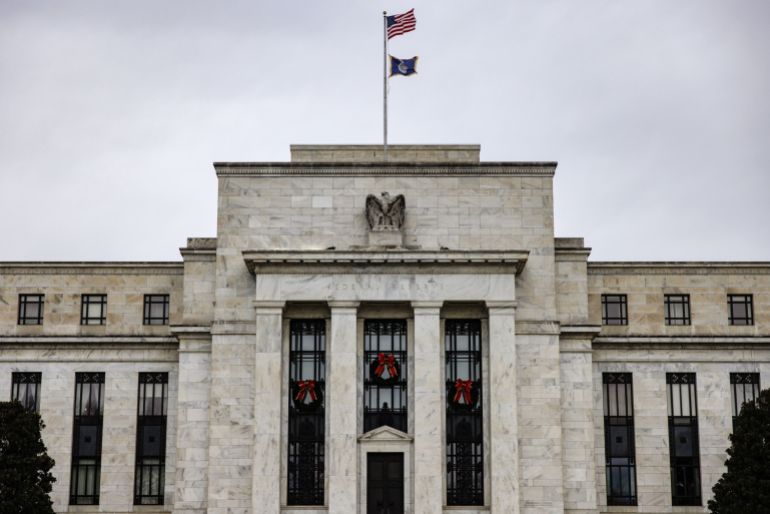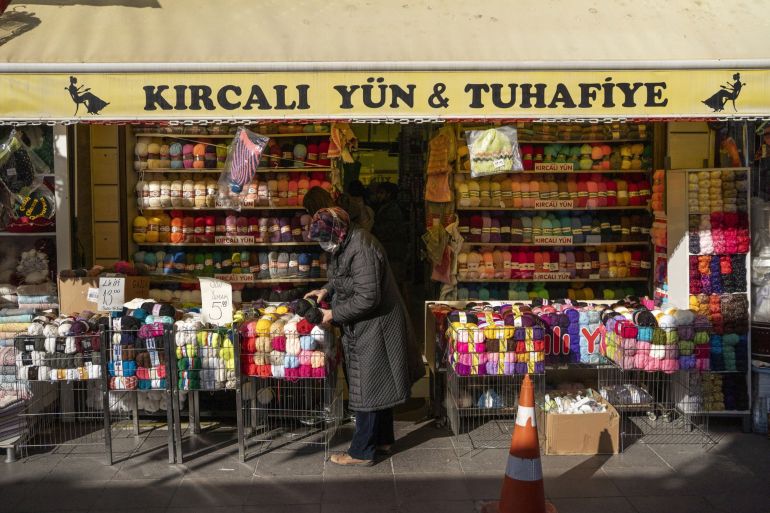Indonesia, Brazil, Mexico, South Africa and Turkey could be roiled when the US Federal Reserve starts raising interest rates, say analysts.
By Michael Moran
If there were a character in literature who best mirrored the power the United States Federal Reserve wields over the global economy, it would be Gulliver. Though he was a decent chap who meant no harm, his very massiveness presented a danger to all around him – in this case, the Lilliputians of the global economy: emerging markets (EMs).
But unlike Gulliver, the Fed is constitutionally prohibited from heeding the cries of Lilliputian economies when crafting interest rate policy. The Fed’s dual remit is narrow and decidedly parochial: Use monetary policy to battle US inflation and maximise the US job market. Preventing chaos in emerging markets simply does not come into it.
Yet some EM chaos may beckon. On Tuesday, Federal Reserve policymakers will kick off their first two-day meeting of this year.
As 2021 drew to a close, the Fed pivoted priorities away from supporting jobs creation by keeping borrowing costs low and towards reining in inflation – which is running near a 40-year high.
To achieve that, it signalled that it is gearing up for at least three hikes to its benchmark interest rates this year.
Since then, speculation has been growing that taming inflation could require four rate hikes, not three, raising the stakes not just for the US economy, but for emerging markets as well.
The last time this happened…
When the Fed raises interest rates, Americans end up paying higher rates on mortgages and credit cards, while US businesses also see their borrowing costs go up. But the effects of the Fed’s liftoff don’t end at the US border.
When the Fed hikes interest rates, borrowing becomes costlier throughout the world. That is especially true of countries that have so-called “dollarized debt” – nations that have taken advantage of the decade-plus of low interest rates by issuing sovereign bonds denominated in dollars, and that now face the prospect of refinancing those bonds in much less favourable conditions.

This mix – a tightening by the Fed combined with high debt or mispriced currency in EM countries – led to some pain in 2013, when the Fed began to “taper” its post-2009 stimulus policy of purchasing US Treasuries.
The impact on even the largest EM markets was quick and brutal as investors began moving dollars to “safe havens” like US Treasuries and out of EM investments. So quick was the outflow of US dollars from the Indian economy that the rupee fell by 15 percent in three months, forcing the Reserve Bank of India to raise rates.
India was not alone. Russia, Brazil, Turkey, Indonesia and other smaller EM economies suffered similar outflows, sometimes exacerbated by political unrest or policy mistakes. As a market segment, emerging market bonds lost over 10 percent of their value in 2013 as a result.
Different this time?
The Fed’s interest rate increases simply cannot be ignored, if for no other reason than it is the steward of the world’s largest economy and the global reserve currency, the dollar. Everything the Fed does has a knock-on effect for share prices, trade flows, supply chains, and sovereign bond and currency markets the world over.
By and large, economists and market analysts are confident that the improved condition of EM balance sheets and generally good economic global growth prospects for 2022 will limit the kind of dislocation experienced in 2013.
Charles Robertson, chief economist at the investment bank Renaissance Capital, told Al Jazeera that the Fed’s plan for gradual tightening has been widely telegraphed, limiting the scope for a “tantrum”. In any case, he said, “Fed hikes usually mean the world economy is doing well, which is good for the emerging markets.”
Robertson, whose bank has a large presence in Russia, the former Soviet Union, the Middle East, North Africa and sub-Saharan Africa, says a bigger concern will be the strength of the US dollar, which could spike after the Fed’s move and make it less likely for global traders to engage in a “carry trade” – an arbitrage strategy that invites investment in high-interest EM vehicles by financial institutions able to procure dollars from the Fed on the cheap.
Fed hikes usually mean the world economy is doing well, which is good for the emerging markets.
CHARLES ROBERTSON, CHIEF ECONOMIST FOR RENAISSANCE CAPITAL
But the tightening in Washington will limit the room EM central banks and governments have to continue stimulating their economies. Rachel Ziemba, a noted China expert and EM economic historian, says that higher Fed rates will make it harder for many EM economies to regain their pre-pandemic footing.
As the year progresses, “it will become more obvious that the short-term international support for the most vulnerable developing economies hasn’t shifted into longer-term support”, she told Al Jazeera.
Ziemba noted that policymakers will need to grapple with this issue at the upcoming April meetings of the International Monetary Fund and World Bank as well as the next Group of 20 summit: “What comes next after the DSSI [debt service suspension] ends and how do they deal with lack of private sector support? Overall growth and domestic demand is struggling in many emerging market countries, due in part to less ability to stimulate than in past crises, as well as market-based adjustments prompting restrictive fiscal and monetary policy.”
But Ruchir Sharma, an EM specialist and chief global strategist at Morgan Stanley Investment Management, is a bit of an outlier, professing confidence that EM economies may reverse a decade of doldrums this year despite the Fed’s tightening.
HSBC, for its part, has been monitoring what it calls the “fragile four” – Indonesia, Brazil, Mexico and South Africa – out of concern that their high dollar-debt levels may make them particularly vulnerable to higher US interest rates. Analysts worry, too, about Turkey, where debt is spiking and a series of interest rate cuts last year in the face of soaring inflation – an unorthodox policy championed by President Recep Tayyip Erdogan – led the Turkish lira to crash.

“President Erdogan is determined to defy orthodox monetary policy,” Stephen Cook, a Council on Foreign Relations expert in Turkey and the Middle East, told Al Jazeera. “This is a recipe for more inflation, economic dislocation in the corporate sector, and generally distrust in economic decision-making.” With Turkey’s foreign reserves almost depleted, its currency tumbling and its economy flirting with hyperinflation, Cook fears any external shock could lead to dire consequences.
Sore muscle memory
If this time is, indeed, different, one can hardly blame EM central bankers and the investment advisers who manage global capital flows for worrying, say analysts.
Ever since the implosion of the US mortgage bond market triggered the Great Recession in 2008, world nations have stood watch for signs that a sudden market swing or policy reversal will send shock waves their way once again. US economic policy, increasingly insular and buffeted by the populist dynamics unleashed by a decade of economic setbacks and futile wars, has stopped pretending to model for anything other than managing relative decline.
And 2013 was only the latest instance of a global crisis sparked by the US-focused Fed. There was the 1994 “Tequila Crisis” in Mexico, which saw the collapse of the peso and a hastily arranged US bailout; the 1997-1998 Asian financial crisis, which led to crushing recessions in the Philippines, South Korea, Thailand, Japan and Indonesia and contributed to the overthrow of the latter’s dictator, Suharto; and the Russia rouble crisis of 1998, which in retrospect drew a line under the free-market reforms of the post-Soviet period and helped usher President Vladimir Putin into office.
Kavaljit Singh, director of the Public Interest Research Centre in New Delhi, said analysts who discount a “Taper Tantrum 2.0” take too sanguine a view of EM economic strength in the midst of the global coronavirus pandemic. While Singh agrees that EM balance sheets are in better shape today than in 2013, he says the enormous expenses and growth hits associated with the pandemic relief and stimulus may offset those structural improvements in emerging market and developing economies (EMDEs).
“The uneven global distribution of COVID-19 vaccines has led to most EMDEs lagging behind their advanced peers,” Singh wrote in the widely read economic blog The Wire. “The slow pace of vaccinations in EMDEs makes them increasingly vulnerable to new waves of infection and the spread of virus variants. The risk of future lockdowns is holding back investment and consumption, thereby delaying the economic recovery in EMDEs.”
The markets continue to see the Fed’s March meeting as the most likely start of the rate increases, as the Omicron variant of the coronavirus once again reminds global markets that there’s more than one invisible hand at play. By then, US inflation may have abated somewhat and a clearer trajectory of both US and global growth may have emerged, negating the need for sudden steep hikes that would almost certainly bring instability to emerging markets.
SOURCE: AL JAZEERA


